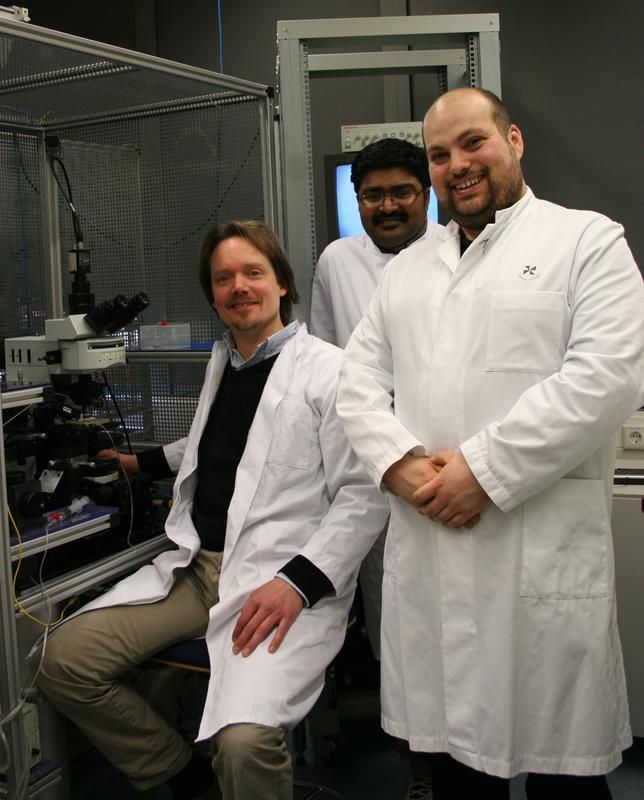Nerve cell diversity gears up movements
A team of scientists led by Dr. Till Marquardt at the European Neuroscience Institute discovered a molecular switch that gears specialized nerve cells, called motor neurons, to control brief bursts of high muscle force required for athletic performance. Published in Science.
(cnmpb) Walking, jogging or sprinting – the faster we move, the more power our muscle have to generate. Different types of specialized nerve cells, called motor neurons, selectively convert nerve impulses from the brain into slow, enduring or very fast movements. Until now it has been unknown what molecular mechanisms make motor neurons so different, how the different types of motor neurons are generated during embryonic development and how exactly each of these players contribute to movements. A team of scientists led by Dr. Till Marquardt at the European Neuroscience Institute Göttingen (ENI-G) and the Center of Excellence Nanosclae Microscopy and Molecular Physiology of the Brain (CNMPB) has now discovered a genetic mechanism that controls the generation of the different types of motor neurons. These new findings could provide the basis for new therapeutic strategies for the decline of muscle function during aging or during neurodegenerative diseases. This new study has been published in the March 14 edition of the prestigious journal SCIENCE.
Original publication: Müller, D., Cherukuri, P., Henningfeld, K., Poh, C.P., Wittler, L., Grote, P., Schlüter, O., Schmidt, J., Laborda, J., Bauer, S.R., Brownstone, R.M., and Marquardt, T. Dlk1 promotes a fast motor neuron biophysical signature required for peak force execution. Science 243: 1264- 1266.
FINDINGS
The Göttingen researchers discovered a gene called Delta-like homologue
(Dlk1), which functions as a molecular switch that orchestrates the activity of
many other genes in motor neurons. However, Dlk1 does so only in a third of all
motor neurons. The Dlk1-dependent genes in turn allow this subset of motor
neurons to become only active when movements of great speed or strength are
needed. What this means in practice has been observed by the researchers:
"mice lacking the Dlk1 gene fail to recruit the extra burst of muscle strength
needed for propelling the limbs during fast running. Mutations in the Dlk1 gene
thus turn mice into poor sprinters.“ Says Dr. Marquardt, lead scientist and senior author of the study. "However, since the other motor neurons responsible for weaker but more enduring muscle actions remain intact, the same mice are still good joggers.“
These new results are the culmination of a seven-year long research effort. The scientists first had to systematically isolate genes derived from the different types of motor neurons. To identify the different motor neuron types the researchers recorded their electrical activity using a technique called patch-clamping that was invented 30 years ago by Göttingen nobel laureates Erwin Neher and Bert Sakmann. Dr. Marquardt’s team then developed a new technique to switch genes either on or off in chicken motor neurons. This way the scientists eventually discovered the Dlk1 gene as a key player in creating motor neuron diversity and function.
INSIGHTS FOR NEW THERAPIES IN NEUROMUSCULAR DISEASES
Apart from providing insights into how the brain controls movements this new work
may pave the way for novel therapeutic strategies targeting neurodegenerative
diseases. For instance, the incurable motor neuron disease amyotrophic lateral
sclerosis (ALS) leads to paralysis and eventual death within a few years after
diagnosis. Intriguingly, ALS first affects the very same motor neurons that require
Dlk1 function for their development. Moreover, the same high muscle force-
generating motor neurons are gradually lost with advanced age in otherwise
healthy subjects. The knowledge of the gene programs regulated by Dlk1 may eventually help resolve why some but not other motor neurons are sensitive to degeneration. This knowledge in turn has the potential to inspire therapeutic strategies for slowing or halting the decline in muscle function during ageing or neurodegenerative diseases.
BACKGROUND
How are nerve impulses from the brain translated into movements? This job is performed by specialized nerve cells, called motor neurons, in the spinal cord and hindbrain. When a motor neuron receives a sufficient number of nerve impulses it responds by firing a volley of impulses that triggers muscle contraction. However, motor neurons differ in the way they respond to nerve impulses from the brain and the muscle actions they drive. For instance, the simple task of keeping the spine erect relies on motor neurons that can fire for virtually indefinitive time periods to drive weak muscle contractions counteracting gravity. Intense athletic movements, such as sprinting or weight-lifting, rely instead on motor neurons that are much less trigger-happy, but can drive explosive release of muscle force once activated. This diversity is thought to assure that each muscle action involves a gradual rise and ebbing of force necessary for fluid movements.
Weitere Informationen:
http://www.eni-g.de European Neuroscience Institute Göttingen
http://www.cnmpb.de Cluster of Excellence and DFG Research Center Nanoscale Microscopy and Molecular Physiology of the Brain (CNMPB)
Ähnliche Pressemitteilungen im idw



